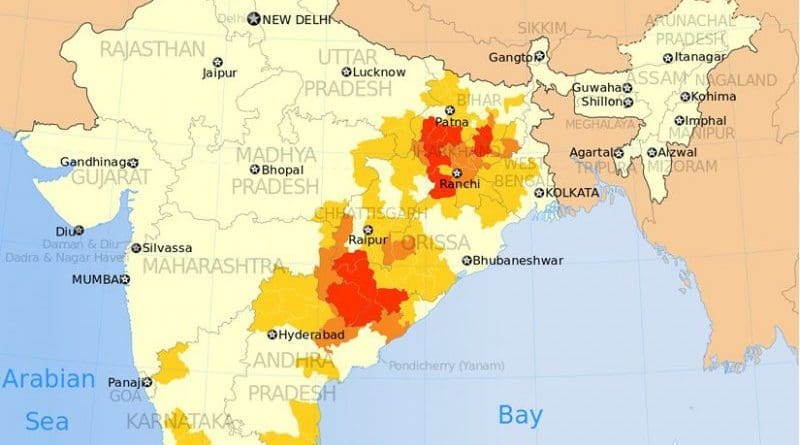Not Exactly ‘Flying’ In The Naxal Heartland – Analysis
A few days ago, some newspapers in India ran two separate reports. One hogging the front page was a stub on India’s flourishing economy and the other relegated to the inside pages underlined the challenges faced by the security forces battling the Left-wing extremists (Naxalites) in the remotest corners of the country. The first item pointed to the soaring number of choppers and private jets jostling for space in Indian skies and the demands they make on the Air Traffic Controllers. The second report, on the other hand, quoted the Border Security Force (BSF) authorities asking the ministry of home affairs (MHA) to replace the Dhruv helicopters since these do not meet the force’s operational requirements. This report went on to detail the drastic shortage of choppers for the security forces deployed on anti-Naxal duty and its impact on the morale of the forces. These two narratives posed a familiar paradox, from Coleridge’s “The Rime of the Ancient Mariner”, when there are “choppers choppers everywhere, but not many for the security forces”.
On May 19, a chopper employed by Gadchiroli district police in Maharashtra returned with injured and dead police personnel from the encounter site at Nalgonda. However, security forces battling the Naxals in Beijjur phata in the same district could not avail themselves of the service of the chopper since it had already completed the stipulated 500 hours of flying and had to proceed for the mandatory maintenance service. The Gadchiroli police requested that the services of another chopper from neighbouring Chhattisgarh be provided. But by the time it arrived, the encounter had ended. It could fly only to recover three dead bodies of police personnel from the area.
A similar incident took place in Jharkhand’s Lohardaga district on May 3 in which 11 security force personnel were killed. The Naxals ambushed a 150- member team of state police and paramilitary personnel returning from a combing operation. While four personnel were killed on the spot, seven others succumbed to their injuries since the chopper at the disposal of the state police was unavailable, being on a sortie to neighbouring West Bengal for poll-related duties. It could reach the incident site only after four hours. The Jharkhand Director General of Police admitted that the personnel died owing to lack of timely medical aid. One of the injured personnel who ultimately survived bemoaned the fact that he had to suffer the excruciating pain for over four hours before being evacuated and admitted into a hospital.
The MHA, since mid-2010, has deployed a fleet of seven choppers for carrying out troop deployment, casualty evacuation and sending reinforcements in the Naxal-affected states. These choppers are based in Raipur (Chhattisgarh) and Ranchi (Jharkhand) and are available to any of the Naxal-affected states on demand. However, on most occasions, this fleet has been found to be highly inadequate to meet the forces’ ground-level requirements. Complains have been made about the frequent servicing requirements of these Advanced Light Dhruv Helicopters and their inability to fly beyond a certain height. They are frequently grounded by the unavailability of spare parts, which makes them almost an unreliable element in the anti-Naxal operations.
In addition to these incidents of shortage, because of unavoidable technical and logistical reasons, choppers have also been diverted on occasions for use by politicians and bureaucrats. Media reports in early May indicated that out of the fleet of seven, only one chopper was functional and was catering to the requirements of the nearly 70 battalions of paramilitary forces deployed against the Naxals throughout the country.
The MHA is planning to wet-lease six new Russian Mi-17 helicopters from private companies for deployment in the anti-Naxal operations. At a purchase price of Rs 45 crore apiece, wet-leasing the Mi-17 helicopters, under which the company lending it provides for the pilot, maintenance and fuel, is a far more affordable option. According to reports, the sorties by these leased machines to the Naxal strongholds could start as early as August 2011. The MHA hopes to reduce its dependence on the ministry of defence, which currently flies the paramilitary troops in the Naxal zones. In any event, the Indian Air Force (IAF) choppers’ “80 flying hours a month” rule is a handicap in terms of using them excessively. On the other hand, the Mi-17 choppers proposed to be taken on lease are fuel guzzlers, but the MHA has no alternative other than accounting for such expense.
In various forums the Union home minister has spoken of the cumbersome procurement procedure coming in the way of providing the best of arms and equipment to the paramilitary personnel. One does not know whether the process of acquiring choppers also faces similar challenges. The proposal to wet-lease 13 Mi-17 choppers is at least an eight-month-old idea, first floated in October 2010. The number of choppers had then been decided on after taking the requirements of the forces operating in a vast territory into cognisance. But for reasons best known to the MHA, the number has now been reduced to six, which is highly insufficient. Meanwhile, the MHA has negotiated in vain with the IAF, which itself gets choppers on lease. Many of the IAF helicopters are deployed in the United Nations’ Congo mission and the move to recall them has not been successful.
For operational purposes, choppers are as basic a requirement for the forces battling the Naxals as any other sophisticated arms and equipment. India’s anti-Naxal policy needs to improve upon the prevailing conditions, on an urgent basis.
The author is a former deputy director in the National Security Council Secretariat (NSCS), a visiting fellow at CLAWS (New Delhi) and a fellow at the Takshashila Institution.
This article first appeared at http://www.business-standard.com/india/news/bibhu-prasad-routray-not-exactly-%5Cflying%5C-innaxal-heartland/437063/

